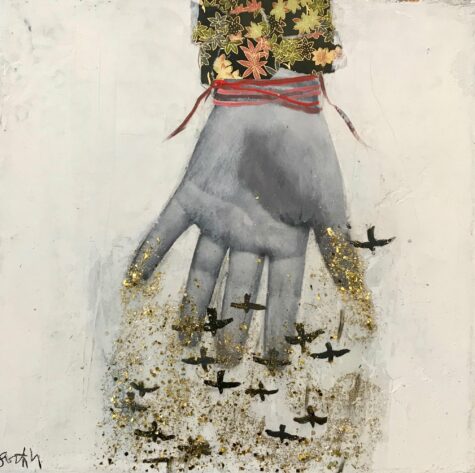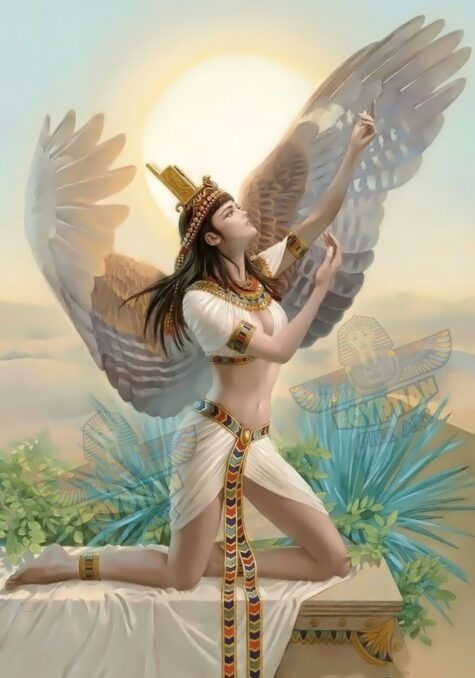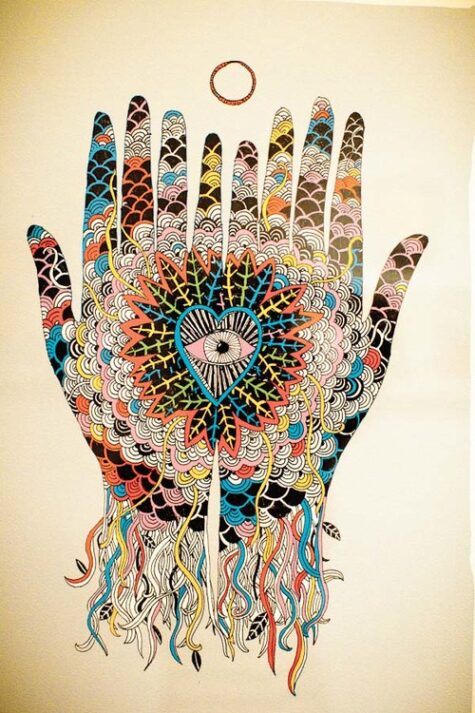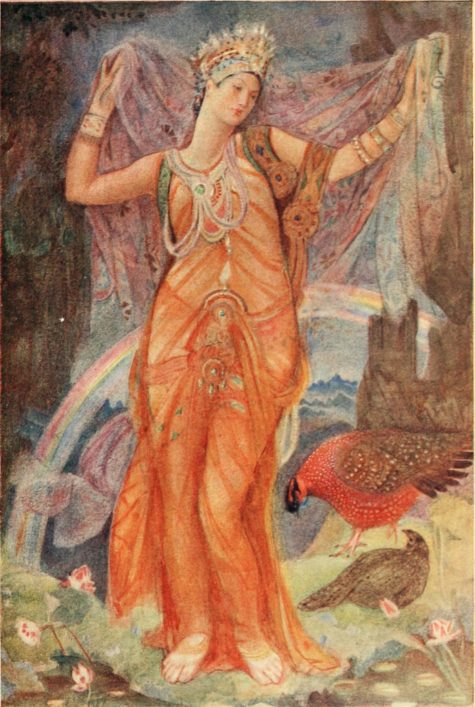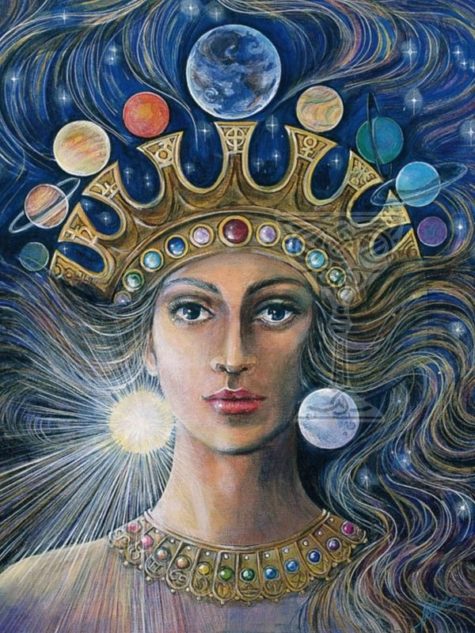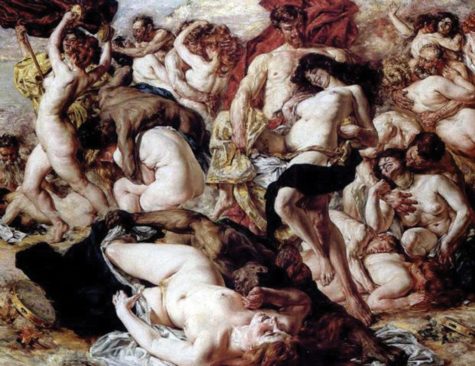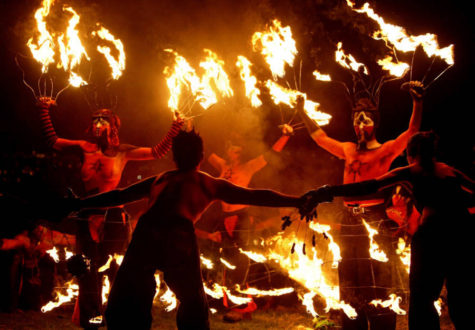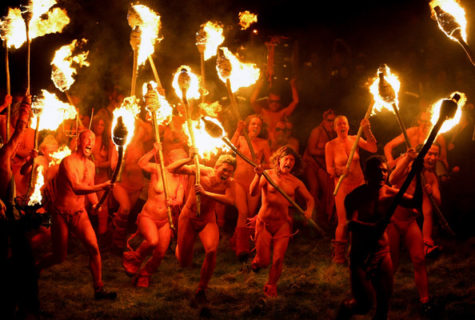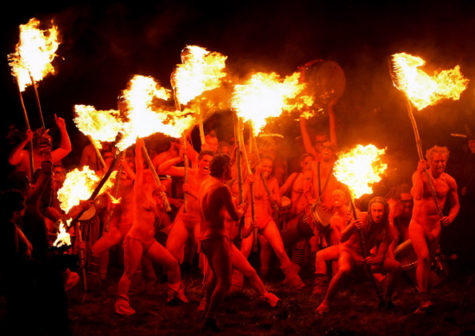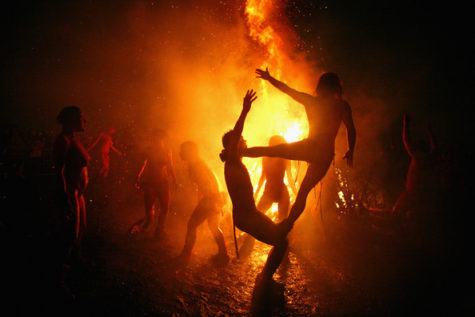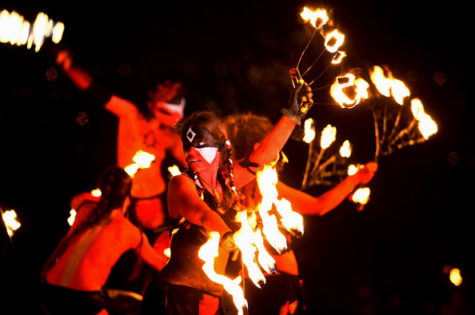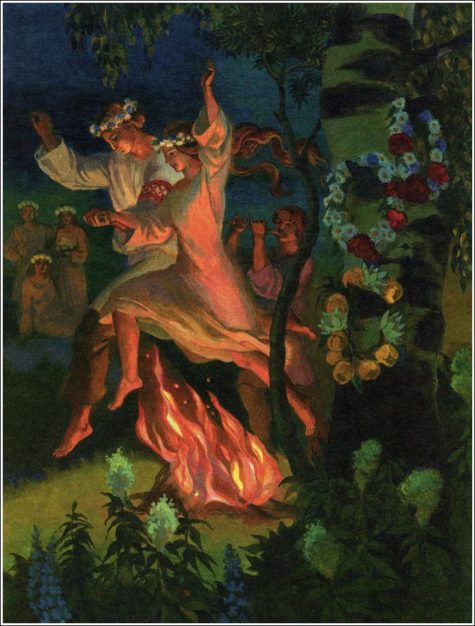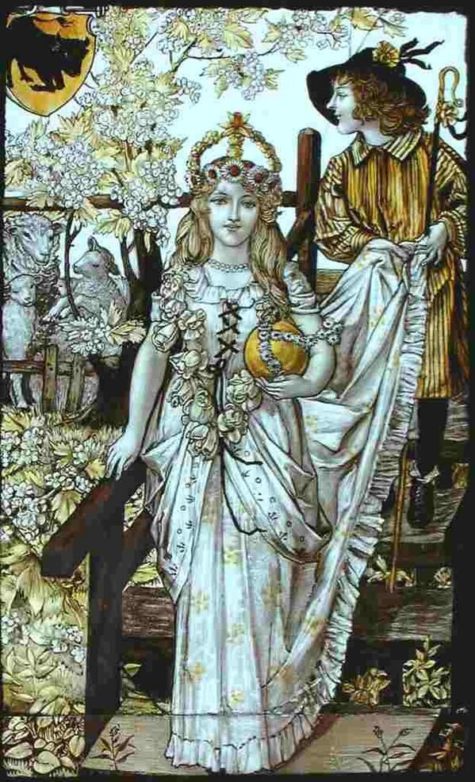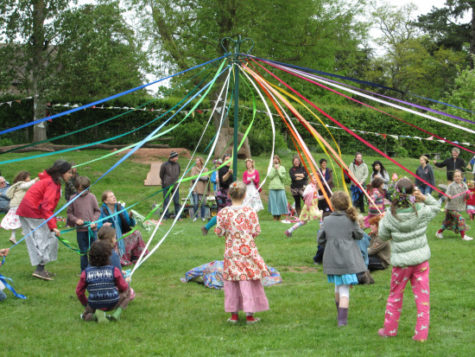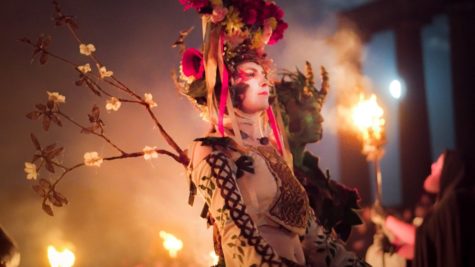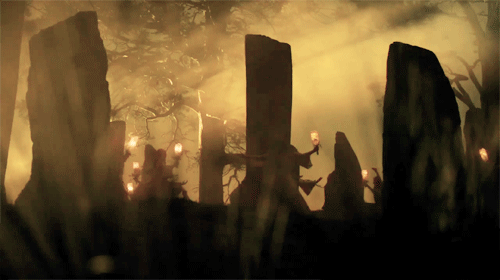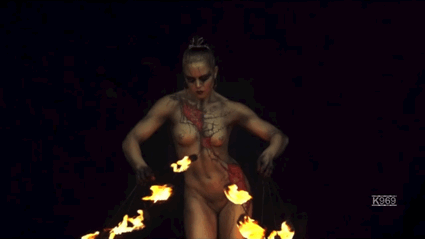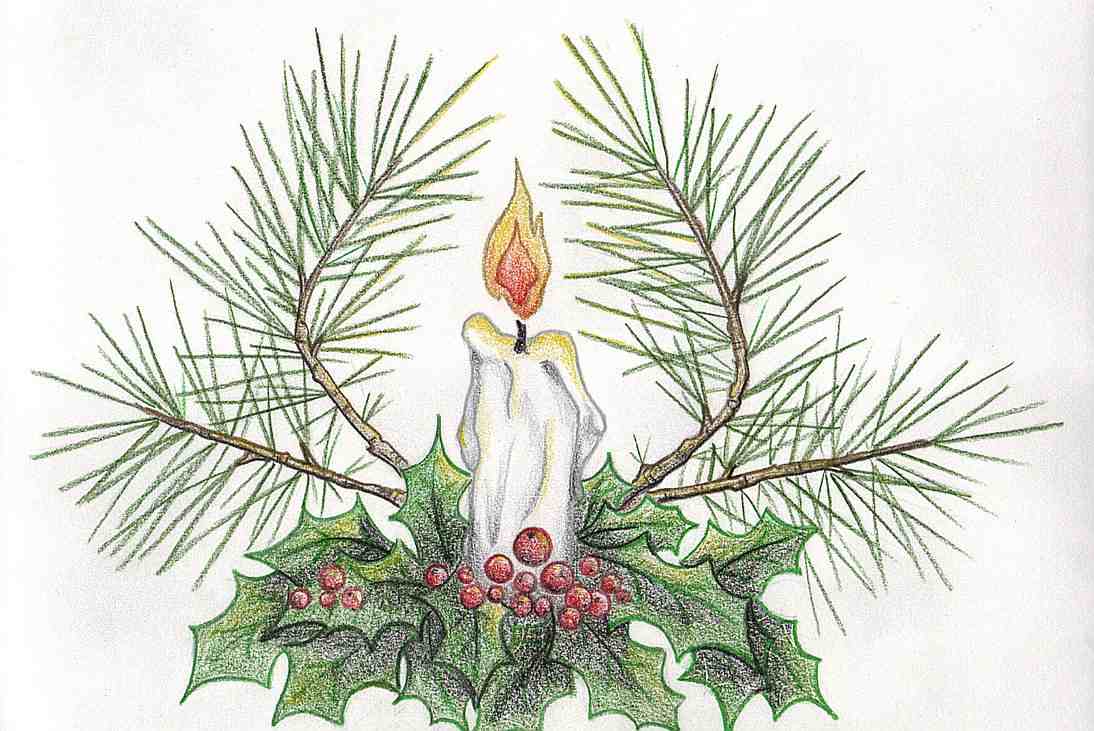Sex
This little-known festival was celebrated at the Temple of Edfu. It doesn’t sound like a Goddess festival, but it is, for the Hand of the God was called Iusaas or Iusaaset. This Goddess, honored in the city of Heliopolis wore a scarab beetle on her head, the symbol of transformation. She was the counterpart of the god Atum, literally his hand.
In the Pyramid Texts an early genesis story recounts how the divine All, the androgynous Atum, created the world from the substance of himself it reads:
“Atum was creative in that he proceeded to masturbate with himself in Heliopolis; he put his penis in his hand that he might obtain the pleasure of emission thereby, and there were born brother and sister ~ that is, Shu and Tefnut.”
Like Isis with whom she is sometimes identified, Iusaaset (whose name means “She Comes While She Grows Large,” a name underscoring the masturbation motif), had a sister called Nebet-hotepet, who is linked with Nephthys. Nephthys name probably means The House of Offering” perhaps referring to the womb of the All which is offered for use during the conception, gestation, and birth of the world.
It is no accident that the Feast of the Hand of the God occurs between two other birth festivals (The Birth of Horus the Younger and the Pregnancy of Nut). It is, after all, a season near the vernal equinox when light has returned to the sky and the days grow in length. It is a time when the world is made new again, when the Hand of the God brings forth life from the waters of chaos. It represents the union of masculine and feminine energies to create and sustain life.
Festival Celebration Ideas
It is unclear how the festival was celebrated in ancient Egypt. Some historians suggest that there might have been sexual rites or ritual marriages. This might be a good time for sex magick, if that is something that you enjoy.
In the Temple of Dendera, which has been called the Castle of the Menat, The Feast of the Hand of the God might have been a day in which all pregnant, including the wives and concubines of the pharaoh, might come to the temple to be blessed. Perhaps the day began with a sunrise devotion to the goddess as Mother of the All.
Perhaps amid the strains of beautiful music, the priestesses touched each pregnant woman’s belly and breasts, or anointed their faces with perfume, or even milk, whispering words of welcome to the unborn children, saying the same words priestesses used to great the nomarch Senbi, “for your spirit, behold the menat of your mother, Hathor. May she make you flourish as long as you desire.”
Hymn to Isis
Enchantress and wife, she stamps and spins.
She raises her arms
to dance. From her armpits arises a hot perfume
that fills the sails of boats along the Nile.
She stirs breezes that make the sailors swoon
and opens the eyes of statues. Under her spell,
I come to myself; under her body I come to life.
Dawn breaks through the diaphanous weave of
her dress. She dances and draws down heaven.
Sparks scatter from her heels and on earth tumbles
forth an expanse of stars…”
Activities For Today
Here are some ideas you might want to explore today. They can, of course, be done at any time.
- Get Creative
The act of creation can be playful, fun, colorful, and messy. Do a Google search and you will find a lot of simple ideas for how to make art with hand prints. This is a fun activity for kids, and the child within.
- Journaling
In your journal, explore what it means to you to be a cocreator of the universe with the Divine.
- Make a Collage
Gather some magazines that you feel free to cut up. Leaf through them, searching for images that appeal to you. Perhaps the images hint at where you focus your energies or where you will focus your energies in the future. Cut out the images and lay them aside. Outline your hands on a sheet of paper.
Slowly, meditatively, begin to trim, sort, and paste the images onto the image of your own hands. You might use the right hand for things that you already create and the left hand for things you will create in the future. Around the edges of these hands, write a myth of yourself as the creator of this world.
- Make a Physical Connection
Our bodies are instruments of our connection to the physical universe. Reestablish a connection to your body’s natural wisdom. With crayon, outline your body on a long sheet of butcher paper.
Begin at the top of your head and record what each part of your body remembers: your hair, your cheeks, your nose, etc. Try to list both joys and sorrows. When you find a part of your body that holds many strong memories, make not of it.
Later, return to that spot and write a dialog with that part of your body.
Source: Feasts of Light
- Themes: Love; Fertility; Passion; Sexuality; Moon
- Symbols: Star; Moon; Lion; Dove
- Color: Gold
- Incense: Eucalyptus
Sometimes known as the sacred prostitute of Babylon, is the Babylonian goddess of fertility, sexual love, and war, Ishtar encompasses the fullness of womanhood, including being a maternal nurturer, an independent companion, an inspired bed partner, and an insightful adviser in matters of the heart.
Having descended from Venus (the planet that governs romance), she is the moon, the morning star, and the evening star, which inspire lovers everywhere to stop for a moment, look up, and dare to dream. Saturday is Ishtar’s traditional temple day, and her sacred animals include a lion and a dove.
Babylonians gave Ishtar offerings of food and drink on this day. They then joined in ritual acts of lovemaking, which in turn invoked Ishtar’s favor on the region and its people to promote continued health and fruitfulness.
That being said, allow yourself today to reflect on embracing your own sexual being. On a piece of paper, list things about your body and your sexuality that make you uncomfortable. Then, light a pink candle and send pink, healing light to any parts of yourself with which you have emotional discomfort. Embrace your sexual self for who you are and find peace within. After spending time for yourself, consider your own sexual relationships. Focus energy on things within them that are not right and comfortable for you. Send healing to those areas as well. Your sexual relationships should bring joy and pleasure into your life. Remember to be safe in them as well. Thank Ishtar for her presence in your life. Finish your meditations and enjoy the vibrancy of the day.
A magickal alternative, if you have no bed partner, is to use symbolism. Place a knife (or athame, a ritual dagger often representing the masculine divine or the two-edged sword of magick) in a cup filled with water. This represents the union of yin and yang. Leave this in a spot where it will remain undisturbed all day to draw Ishtar’s loving warmth to your home and heart.
If you have any clothes, jewelry, or towels that have a star or moon on them, take them out and use them today. Ishtar abides in that symbolism. As you don the item, likewise accept Ishtar’s mantle of passion for whatever tasks you have to undertake all day.
A Ritual For Ishtar’s Day
- Color: Pottery red, terra cotta
- Element: Earth
- Offerings: Grains. Stars. Give food to those who need it.
- Daily Meal: Wholegrain bread. Cooked grains. Milk and dairy products.
Altar: Set with a cloth of earthy red, and on it place a pitcher of milk and another of wine, bowls of wood and clay filled with grains, olives, figs, and dates, a star, and the figure of a lioness.
Ishtar Invocation
I beseech thee, Lady of Ladies,
Goddess of Goddesses,
Ishtar, queen of all cities,
Leader of all men.
Thou art the light of the world,
Thou art the light of heaven.
At thy name the earth and the heavens shake,
And the gods they tremble;
The spirits of heaven tremble at thy name
And the men hold it in awe.
Where thou glancest the dead come to life,
And the sick rise and walk;
And the mind that is distressed is healed
When it looks upon thy face.
Call and response:
For lo, I am the Keeper of the Storehouse
And I am generous to all men!
From my breasts nourishment spills
From my hands nourishment flows
From my heart nourishment streams
I am the Morning Star
I am the Evening Star
I am the Star of Heaven
And I give unto all humanity.
(After this, all should being the work of inventorying all the resources of the house, in Ishtar’s name, so that they may be used more efficiently and that it can be known what can be given to others out of generosity.)
Sources:
Nowadays, whenever we hear the term Bacchanalia getting thrown about it is typically used to describe wild partying that has gotten way out of control. In the popular imagination, the Bacchanalia are often characterized by frantic participants moshing together in a pit of sexual orgies.
The Bacchanalia were free-spirited and sexually charged festivals that involved pagan mysticism, wild sex and divine communion which allowed its celebrants’ to achieve states of euphoria that hovered between divine ecstasy and the oblivion of nothingness. Those who have spent a week at one of the Hedonism resorts in Jamaica would probably find the sexually charged atmosphere of the Bacchanalia remarkably familiar.
The cult of Bacchus was a mystery religion that originated in Asia Minor (modern day Turkey) and spread throughout Greece and into southern Italy where it became extremely popular among the Romans. Despite their notoriety, not much is known about the Bacchanalia. This is largely due to the fact that mystery religions were closed to the uninitiated and their inner-workings kept secret from the outside world. However, scholars have managed to piece together fragments from ancient legal documents, historical texts and plays that can help give us a glimpse into the bacchanalian festivities.
The Bacchanalia first appeared in Greece around 700 BC and eventually found their way into Italy around the fourth century BC. The first bacchanals were held twice yearly in the middle of winter and were reserved for girls and women who performed their rites naked. By the time Rome had become the preeminent power in the Mediterranean after their victory over Carthage in the Second Punic War (202 BC), the rituals had opened up considerably making them quite popular with the natives.
Admission was extended to men and people of all social classes; even slaves could even join in on the fun. With the increased popularity, celebrations were taking place as often as five times a month.
The time and location of the bacchanals were usually closely guarded secrets. Priests and priestesses preferred to hold their gatherings in secluded forests where their privacy could be ensured. On the day of the festival, devotees would prepare some goats by painting their horns gold. Special torches dipped in sulphur and charcoal was also made. Devotees often wore fawn skins that emulated forest animals. Skimpy outfits or even complete nudity was also par for the course. Participants would often carry along their favorite sex toy; women would bring sexy wands while men might bring along a wooden phallus.
After nightfall celebrants would proceed to a forest clearing by dancing to the sounds of crashing cymbals and loud music. Once the celebrants arrived at the appointed place, they could be seen quaffing down wine, dancing, leaping, whirling, screaming and generally working themselves up into a frenzied state. They would inspire each other into ever greater acts of ecstasy, whereby the whole scene would descend into a writhing mosh pit of sexual orgies.
The aim was to achieve a heightened state of ecstasy in which the devotee’s souls would be temporarily freed from their physical existence. It was in these moments that the worshipers hoped to commune with Bacchus and obtain a glimpse of what they would someday meet in the afterlife after their resurrection.
The festival would reach its climax with frantic feats of strength and ecstasy, such as ripping trees out of the ground and eating the raw flesh of their sacrificial animals. The latter act was a sacrament similar to communion where the devotees assumed the identity of Bacchus. By symbolically drinking his blood and eating his body, the devotees believed they became one with Bacchus.
The euphoric devotees would then rush over to the banks of a nearby river with their flaming torches and dip them into the water. Since their torches were made with sulfur and charcoal, they would emerge from the water still burning, a symbol of Bacchus’s power.
Source: The Bacchanalian
Here’s how they celebrate Beltane in Edinburgh!
Enjoy!
First organized in the 1980’s, the Beltane Fire Festival has become a popular festival in Edinburgh. Here we have photos of the Beltane Fire Society celebrating Spring and the coming of summer. This lively procession celebrates the ending of winter and is a revival of the ancient Celtic festival of Beltane which is the Gaelic name for the month of May. More about Beltane can be found here: Beltane
The first of May is Beltane or May Day, a time to celebrate the leaping fires of passion. Traditionally celebrated on April 30, (May eve), it marks the height of spring and the flowering of all life. Beltane is a festival of sensuality, sexuality, flowers and delight. It is a traditional time to make love, preferably outdoors.
Beltane is the time when fairies return from their winter rest, carefree and full of mischief and delight. On the night before Beltane, in times past, folks would place rowan branches at their windows and doors for protection. If you do not wish the fairies to visit, do the same! This is also a perfect time for night or predawn rituals to draw down power to promote fertility in body and mind.
At Beltane, the Pleiades star cluster rises just before sunrise on the morning horizon. The Pleiades is known as the seven sisters, and resembles a tiny dipper-shaped pattern of six moderately bright stars in the constellation of Taurus, near the shoulder. Watch for it low in the east-northeast sky, just a few minutes before sunrise.
There are many lovely old customs associated with this time. Here are some simple ideas for celebrating this wild red time of year:
- Make a garland or wreath of freshly picked flowers and wear it in your hair.
- Dress in bright colors, especially hot pink or crimson, the traditional colors of Beltane, or wear green all day (and nothing all night!)
- Hang fruits and baked goodies from trees and bushes for later feasting.
- Build a Beltane fire: leap over it to cleanse yourself, or state your desires and let the fire carry them upward.
- Leap over your garden rows (or house plants), sharing joyous energy.
- Make a ‘May gad’: peel a willow-wand and twine cowslips or other flowers around it.
- Throw a May Day party and feast on May wine and food till the dawn. Turn a broomstick into a maypole and see how many people you can get to dance round it.
- Make love in the woods, in your garden, outside – at night.
- Watch the sunrise. Pack a picnic breakfast, a blanket, and some sweaters; and head out before dawn. Unpack your picnic on a hill with an unobstructed view and enjoy the early morning rays as the sun peaks over the horizon.
- Make a flower feast! Freeze edible flowers in your ice cubes. Add edible flowers to your salad. Candy flowers to decorate your dessert.
- Make a May basket. Fill it with flowers, food, ribbons, and fun. Leave it on a doorstep of a lover or friend, or someone who cannot get outside, such as an invalid or elderly person.
- Make a daisy chain and cast it into one of the lakes to please the water spirits.
- Rise at dawn on May Day and wash in the morning dew: The woman who washes her face in it will be beautiful, the man who washes his hands will be skilled at knots and nets (always a useful skill for students).
- Twist a Rowan sprig into a ring and look through it- tonight is one of the three in the year when the uninitiated can see the faeries.
- Create a May Day altar with a mirror, a small maypole, a phallic shaped candle, a daisy chain and springtime flowers.
- Light a fire or candle on the top of a hill and make a wish as you jump over it (for authenticity, you can try this sky clad, it would also be amusing for any passing late-night dog walkers!)
- Perfume your house with delicate scent of woodruff, a tiny, star-like flower that blooms around this time in the Northern Hemisphere.
- Embrace the ones you love. Hugs and kisses all around.
Holidays are days made holy by the attention we pay them. Simple practices such as the ones listed above remind us that we too dance to the natural rhythms of the earth.
Honor The May Queen
Make an offering of a floral crown, or a libation of honey and milk, to the Queen of the May during your Beltane prayers.
The leaves are budding across the land
on the ash and oak and hawthorn trees.
Magic rises around us in the forest
and the hedges are filled with laughter and love.
Dear lady, we offer you a gift,
a gathering of flowers picked by our hands,
woven into the circle of endless life.
The bright colors of nature herself
blend together to honor you,
Queen of spring,
as we give you honor this day.
Spring is here and the land is fertile,
ready to offer up gifts in your name.
we pay you tribute, our lady,
daughter of the Fae,
and ask your blessing this Beltane.
Make A Maypole for Beltane
This isn’t as difficult as you might think. Purchase a twenty foot wood pole from your local hardware store, or make a shorter one with a yardstick, broomstick, or even a twig. Set it up in your backyard.
Invite a group of friends, and ask each one to bring a 2 inch by 20 foot length of brightly colored ribbon (or whatever the length of your pole). Alternatively, you could provide ribbons of various colors. At the top of the pole affix the different colored ribbons – one for each person.
When your guests have assembled, have them each choose a ribbon and make a wish upon it.(For example, “I choose this red ribbon for more passion in my life.”) Everyone grabs their ribbon, and the dancing begins. (Make sure to have extra ribbons just in case!) Dance around the Maypole entwining your ribbons together. And then feast on May wine and food till the dawn.
More About Beltane
For the Celts, Beltane marked the beginning of the pastoral summer season when the herds of livestock were driven out to the summer pastures and mountain grazing lands. In modern Irish, Mí na Bealtaine (‘month of Bealtaine’) is the name for the month of May. The name of the month is often abbreviated to Bealtaine, with the festival day itself being known as Lá Bealtaine. The lighting of bonfires on Oidhche Bhealtaine (‘the eve of Bealtaine’) on mountains and hills of ritual and political significance was one of the main activities of the festival.
Beltane is a cross-quarter day, marking the midpoint in the Sun’s progress between the vernal equinox and summer solstice. Since the Celtic year was based on both lunar and solar cycles, it is possible that the holiday was celebrated on the full moon nearest the midpoint between the vernal equinox and the summer solstice. The astronomical date for this midpoint is closer to May 5 or May 7, but this can vary from year to year.
In Irish mythology, the beginning of the summer season for the Tuatha Dé Danann and the Milesians started at Bealtaine. Great bonfires would mark a time of purification and transition, heralding in the season in the hope of a good harvest later in the year, and were accompanied with ritual acts to protect the people from any harm by Otherworldly spirits, such as the Sídhe.
Like the festival of Samhain, opposite Beltane on Oct. 31, Beltane was a time when the Otherworld was seen as particularly close at hand. Early Gaelic sources from around the 10th century state that the druids of the community would create a need-fire on top of a hill on this day and drive the village’s cattle through the fires to purify them and bring luck (Eadar dà theine Bhealltainn in Scottish Gaelic, ‘Between two fires of Beltane’).
In Scotland, boughs of juniper were sometimes thrown on the fires to add an additional element of purification and blessing to the smoke. People would also pass between the two fires to purify themselves. This was echoed throughout history after Christianization, with lay people instead of Druid priests creating the need-fire.
The festival persisted widely up until the 1950s, and in some places the celebration of Beltane continues today. A revived Beltane Fire Festival has been held every year since 1988 during the night of 30 April on Calton Hill in Edinburgh, Scotland and attended by up to 15,000 people (except in 2003 when local council restrictions forced the organizers to hold a private event elsewhere).
Wiccans and Wiccan-inspired Neopagans celebrate a variation of Beltane as a sabbat, one of the eight solar holidays. Although the holiday may use features of the Gaelic Bealtaine, such as the bonfire, it bears more relation to the Germanic May Day festival, both in its significance (focusing on fertility) and its rituals (such as maypole dancing). Some Wiccans celebrate ‘High Beltaine’ by enacting a ritual union of the May Lord and Lady.
~Information from various sources including Paganwiccan
